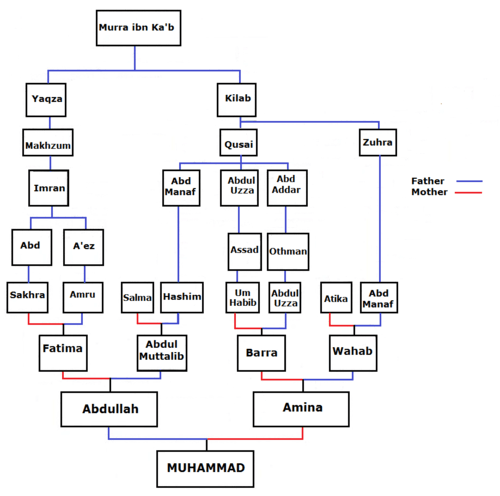Wahb ibn Abd Manaf
Wahb ibn 'Abd Manaf (Arabic: وهب بن عبد مناف) ibn Zuhrah ibn Kilab ibn Murrah was the chief of Banu Zuhrah, and the father of Aminah bint Wahb. He was thus the grandfather of Islamic prophet Muhammad.[1]
Wahb ibn 'Abd Manaf | |
|---|---|
| Known for | Grandfather of Muhammad |
| Spouse(s) | Barrah bint Abdul Uzza |
| Children | Halah bint Wahb (daughter) Aminah bint Wahb (daughter) |
| Parent(s) | 'Abd Manaf ibn Zuhrah (father) Qaylah (Hind) bint Wajz (mother) |
| Relatives | Halah bint Wuhayb (niece) |
Family

Wahb's grandfather was Zuhrah ibn Kilab, the progenitor of the Banu Zuhrah clan[2] of the Quraysh tribe in Mecca.[1] His mother Qaylah (Hind) bint Wajz Ibn Ghalib of Banu Khuza'a.[3] His brother was Wuhayb ibn 'Abd Manaf.[4]
Wahb was married to Barrah bint Abdul Uzza of the Banu Abd ad-Dar clan of the Quraysh tribe. Wahb's chief wife, Barrah bint Abdul Uzza, was a great-granddaughter of Qusayy, and his other wife was Rughaybah bint Zurarah ibn Addas, one of the eminent women of Yathrib (Medina). His son, Abdu Yaghuth, was himself a notable chief.[4]
After Wahb ibn 'Abd Manaf
When Wahb died, and possibly also his wife Barrah (for there is no other mention of her) Ayyilah took Barra's daughters Halah and Aminah into her care. The widow Rughaybah chose not to accept the proposal of her husband's brother, but instead married Qays ibn Amr of the Banu Adiy ibn Najjar, returned to Yathrib, and in due course gave birth to Salmah (Umm Mundhir), and Salit. Ayyilah also had a daughter of her own of marriageable age, also called Halah.[4]
When Abdullah ibn Abdul-Muttalib[5] reached the right age his father, Abdul-Muttalib began searching for a wife for him. One of Abdul Muttalib's cousins, Muttalib's daughter Ayyilah, was already married into the Banu Zuhrah; her husband was Zuhrah's grandson and Wahb's brother, Wuhayb. Abdul-Muttalib requested Halah for himself, despite being over 70 years old. Halah's age is not known, but Aminah was about 15 when she married Abdullah. Both girls gave consent and the two marriages were organised to take place at the same time.[4]
See also
- Family tree of Muhammad
- Barrah bint Abdul Uzza
- Aminah bint Wahb
References
- Ibn Hisham. The Life of the Prophet Muhammad. 1. p. 181.
- Watt, W.Montgomery (1998). The History of Al-Tabari: Biographies of the Prophet's Companions and Their Successors. 39. State University of New York Press, Albany. p. 107. ISBN 978-0791428207.
- Ibn Sa'd al-Baghdadi. Kitab al-Tabaqat al Kabir. 1.
- Maqsood, Ruqaiyyah Waris. "The Prophet's Family Line No 6 - Abdullah, and the Birth of the Prophet". Ruqaiyyah Waris Maqsood Dawah. Retrieved 29 April 2014.
- Lings, Martin (1983). Muhammad: His Life Based on the Earliest Sources. George Allen & Unwin. p. 6. ISBN 0946621330.